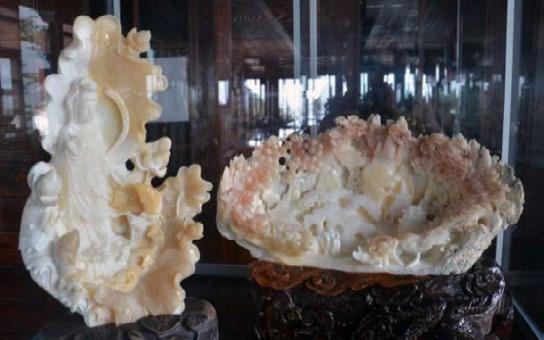
2 minute read
Analysis of giant clam shell seizures in China
In the period from January 2016 to July 2021, analysis of open sources33 identified 46 seizures reported in China relating to smuggling or harming giant clam shells, including illegal transportation, purchasing, or selling. Of these cases, 21 seizures involved raw giant clam shells, 19 seizures involved carved shell products, and six cases were mixed seizures of both raw shells and carved products. The following analysis of the reported seizures in China can provide a limited picture of some aspects of the trade, but further investigation is needed to identify the trafficking routes and modus operandi of the giant clam shell supply chain.
China reported seizures of giant clam shells or shell products every year in the research period, as illustrated in Figure 3. The number of seizures spiked sharply from six cases in 2018 to 18 cases in 2019, before decreasing in 2020 to 10 cases. This spike appears to be due to a larger number of cases of illegal trade of giant clam shells or shell craft, or the detection of it, compared to previous years. It is possible that this could be the result of increased monitoring and enforcement efforts as a follow on from the strict enforcement of China’s ivory trade ban. There was a relative decline in reported cases in 2020, which could be a consequence of the restrictions and changed dynamics related to the COVID-19 pandemic, but the number of seizures relating to illegal trade was still high compared to the years 2016-2018.
Advertisement
Although China is a suspected destination of the giant clam shell stockpiles in the Philippines, there have not been any corresponding reports of significant clam shell seizures in China during the same period that could indicate supply chain links, and currently only minimal intelligence has been identified that presents a linkage between the two countries. Only two of China’s 46 cases relate to large quantities of shells, while 96% (44 cases) relate to smuggling and illegal trade of smaller, retail-level quantities of shells and shell crafts. Open-source research was also unable to identify any major clam shell seizures made by other countries. The low level of detection of significant quantities of contraband outside of the Philippines suggests that this trade is largely being conducted with impunity.
Figure 3: Number and type of giant clam shell seizures reported in China from January 2016 to July 2021.34
33 Sources included convictions recorded on the Chinese Judgements Online official service (https://wenshu.court.gov.cn/) and media reports. 34 In this chart, illegal trade refers to seizures that involved the illegal transportation, purchase, or sale of giant clams within China. Smuggling refers to seizures that were made upon the detection of giant clam shells or shell products entering China at a border point.
Giant clam shell seizures have been reported in almost every province along China’s east coast, with 41% of seizures taking place in Guangdong province (19 cases), and most of these were in the major cities of Guangzhou and Shenzhen. This was followed by Guangxi Zhuang Autonomous Region (five cases), all of which were giant clams that had been smuggled across the border from Vietnam into China. Only four seizures were reported in Hainan province during the period, despite it being the epicentre of the clam shell carving industry and the provincial ban on giant clam trade enacted since 2017.
Figure 4: Reported locations of giant clam shell seizures in China from January 2016 to July 2021.35










